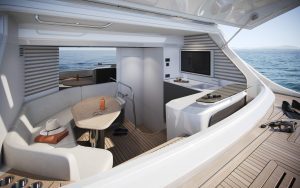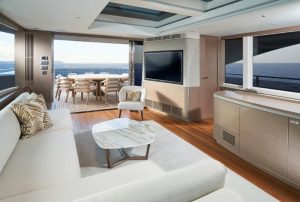The marine industry’s definitions are notoriously difficult to pin down. If you want proof of that, just ask your boating friends to draw meaningful distinctions between a runabout and a dayboat. Or a dayboat and a cuddy. Or a cuddy and a weekender. Or a weekender and a cruiser. Chances are, you will get a range of answers that add little, if any, clarity to the debate. And in the past decade or so, that overlapping of boat types has begun to blur the boundaries between the luxury yacht and the superyacht too. While once, a superyacht was a highly customised luxury yacht in excess of 100 feet, designed and built in line with the ambitions of a wealthy owner, it’s no longer so clear-cut. After all, the 24m ‘Pleasure Craft’ RCD threshold dictates that any vessel of 100 feet or more has to be registered as a commercial vessel and staffed by a professional crew – and that brings with it a degree of cost and complication that a lot of owners simply don’t want. So with the help of modern construction techniques and some truly ingenious yacht designs, the market has adapted. We are witnessing the dawn of the ‘mini superyacht’ – a sub-100-foot boat that fits neatly within the 24m ‘Pleasure Craft’ RCD limit so you can enjoy a proper taste of superyacht space and prestige, while retaining the simplified costs and logistics of a large ‘self-drive’ leisure boat.
Key features of the self-drive superyacht
As high-end boat builders have tapped into the market’s demand for ‘compact superyachts’, there’s been a surge in fresh design ideas to help smaller vessels encompass some of the key techniques and technologies that make the superyacht experience so special. In addition to the increased internal volume that resin infusion brings, we’re seeing cleverly re-routed side decks that enable the forward quarters of a motor yacht to leverage the full beam of the boat. We’re seeing a lot of vessels that use steeper, less tapered superstructures to help maximise that space, alongside expansive structural glass sections to help streamline the aesthetic profile, while improving natural light and opening up panoramic sea views from the various living spaces. We’re also seeing an increased variety of inside and outside zones to eat, drink and relax, as well as some welcome extra flexibility in the form of drop-down balconies and fold-out decking. Extra attention is being paid to the discreet separation of crew routes for improved guest privacy too. And in addition to convertible foredeck party zones and expansive aft Beach Clubs, we’re seeing a lot of fresh ways to encompass that most iconic of superyacht luxuries – the full-beam main-deck master suite.
Y Class superyacht: Princess Y95
Thanks to several features fed through from Princess’s M class superyachts, the ultra-refined Y95 is a great example of the modern sub 100-foot superyacht. With the longest hull windows ever installed on a Princess yacht, both the main and lower decks enjoy vast panoramic sea views. The four en suite guest cabins of the lower deck are supplemented with a wonderfully private full-beam master suite on the forward part of the main deck. And the optional beach club is a superb extension to the yacht’s day spaces, with relaxed seating, an elegant galley and outstanding integration with the aft cockpit and the vast hydraulic swim platform. While the Y95’s 26-knot performance is blissfully quiet, this flagship model is also as adaptable as it is refined, with a vast choice of inside and outside spaces, both for sociable fun and for restful seclusion, all lavished with a calibre of fit and finish that are a match for the world’s most exclusive superyachts.

X Class superyacht: Princess X95
By bringing together the range and practicality of a compact explorer vessel with the space and luxury of a custom superyacht, the flag bearer for the new Princess X Class ‘Superfly’ family elevates the yachting experience to an altogether new level. More voluminous and open-plan than traditional Princess designs, it provides about 30% more internal space than a conventional flybridge yacht of a similar size. And while that is clearly evident on the open-plan main deck and in the generosity of the four lower deck en suite cabins, the ‘Superfly’ itself is something truly special. It features a highly versatile raised wheelhouse with a private climate-controlled Sky Lounge, ahead of a vast single level deck space that enables you to tailor the layout in whatever way you, your guests and your cruising grounds require.

The Princess Motor Yachts Division
While for many, the 70 to 100-foot motor yacht sector now represents the perfect compromise between yachting ability and ownership simplicity, there’s no doubt that large yachts require more complex logistical support than small ones. So to help ensure that the user-friendliness of Princess’s X and Y Class ‘superyachts’ is fully realised, Princess Motor Yacht Sales has set up a dedicated Motor Yachts Division. Designed specifically to help you pick the right yacht, the right options and the right ownership and management structures, it delivers the full spectrum of services relating to large yacht ownership. That includes insurance and financing solutions, as well as legal ownership advice tailored to your personal circumstances. If required, it can also take care of sourcing the right Captain and crew, as well as the right berth for you, your yacht and your cruising ambitions. And whether you choose to offer your yacht for charter or not, the Motor Yachts Division’s network of mobile engineers means you have access to 24-hour support, whenever and wherever you need it.
More super than a superyacht?
The result of this trickle-down effect of features, technologies and service support systems from traditional superyachts to sub 100-foot motor yachts is that, for most of us, the ‘faux superyacht’ is actually better than the real thing in almost every regard. It is more affordable to buy, thanks to the industrial economies of the production and semi-custom process. It is more affordable to run, thanks to the fact that you need neither a professional crew, nor commercial registration. And it’s more practical to own and use because it can access harbours, marinas, coves and anchorages that might be off limits to larger vessels. True, the sheer space and prestige of an authentic superyacht is generally greater – but such are the latest designs of many sub-100-foot ‘superyachts’ that the compromises are all but eliminated. We are seeing beautiful external designs, pioneering deck arrangements and internal volumes that, a decade ago, might have required an extra 30 feet to achieve. And in line with the burgeoning demand for luxury yachts, that means we’re seeing more superyachting freedom, refinement and individuality on sub-100-foot boats than the market has ever witnessed before.
Find out more at: www.princess.co.uk/class/x-class-yachts/
